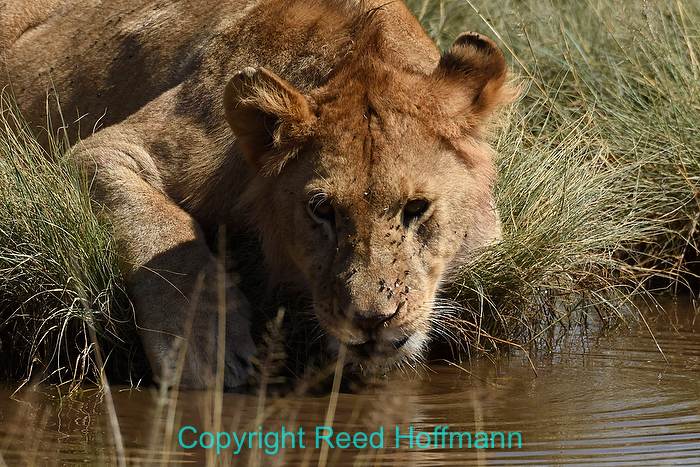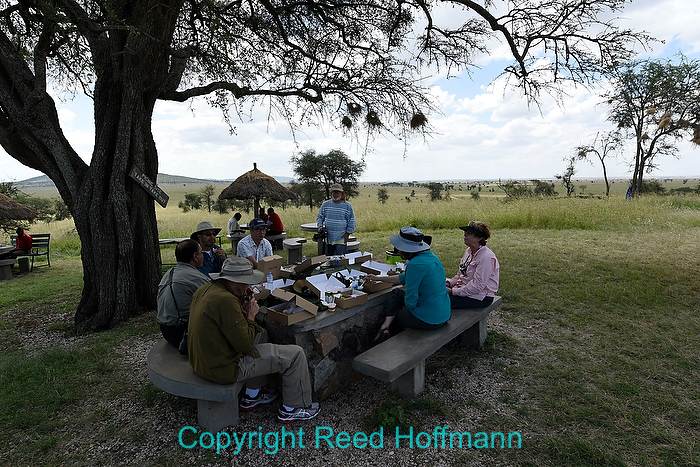This summer I’m leading another photo safari to Tanzania and the Serengeti, for Mentor Series. I’ve led this same trip five times previously, so thought I’d write a story telling those attending what to expect. And, if you’re interested in doing a trip like this in the future, I’ll probably be returning in 2017. This story is the nuts and bolts about the trip. If you want to see photos from past trips, look here.
Flights and Arrival
For most people, there are two main ways to get there: SkyTeam Alliance (Delta and KLM), which is the fastest way (still around 28 hrs, depending on connections). Star Alliance (United, Ethiopian, Turkish) is the other one, but adds another connection (you get to visit Addis Ababa or Istanbul!) and more hours.
When you arrive, you’ll want to get off the plane as fast as possible, get inside, grab an immigration form, fill it out and get to the visa window. If you’re not quick about that, you can have a long wait. And make sure you have a crisp new $100 bill to pay for the visa – that will speed things up too. Also, while it used to be required to have proof of Yellow Fever immunization to enter the country, now that’s only if coming from a country that has Yellow Fever. If you’re coming from the U.S., then you can walk right by the people asking to see that proof. Just tell them you’re arriving from the U.S.
After paying for the visa, you’ll pass through an immigration checkpoint (electronic fingerprints and all) and then you’ll be in baggage claim. After grabbinh your bag, walk out and look for your transfer to the hotel, which should be someone with a sign.
As you may know, schillings are the local currency, and you can exchange U.S. for them at the airport. There aren’t any ATM’s in the Serengeti, so I usually get a bunch of schillings at the start and also bring a bunch of U.S. $1 bills. Those greenbacks are handy for tips (luggage, room, etc.). You can usually pay for drinks with either U.S. or schillings, although as expected, it’s a bit cheaper to pay with schillings. Just make sure your U.S. bills are clean and new (no tears or markings on them, not crumpled), or they may be refused. Also, most lodges have a tip box in the lobby, so you can tip for service from the entire staff when leaving, rather than tipping at dinner, in the room, etc.
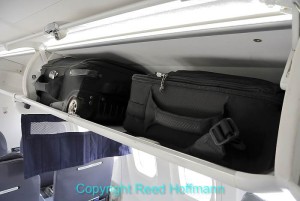
Make sure and check the size and weight restrictions for overhead bins before traveling, or you may have to gate check your camera gear. Photo copyright Reed Hoffmann.
As far as traveling with luggage and gear, I find that going as light as possible makes life easier. As I’ll explain below, I use a smallish backpack that holds all my gear (it even fits in the overheads of the small commuter planes I fly in the U.S). I’ll also have a small fanny pack (Thinktank Speed Demon) that lets me keep items handy on the plane (earbuds, eye shades, book, etc.). I take just one piece of checked luggage that weighs under 40 lbs. On safari our checked luggage will travel behind the back seat of the trucks, but if you bring too much, it will have to go in the passenger area, reducing room for everyone. You can go light on clothing because the lodges do laundry, and the last two we’re for at two nights, so it’s easy to get wash done then. Plus it’s cheap.
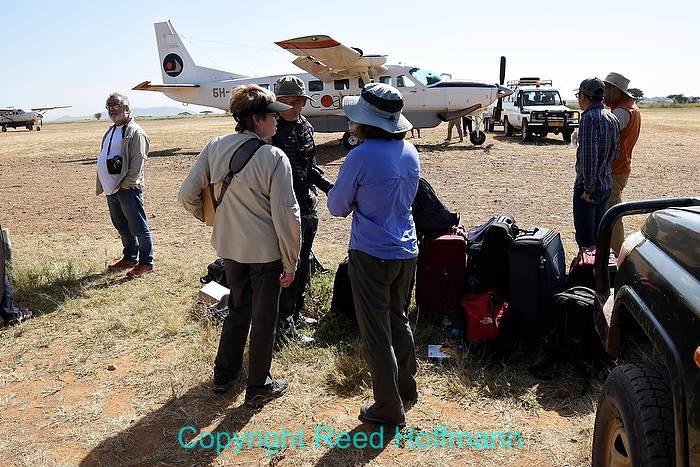
This is the size of the plane that we’ll fly back from the Serengeti in. All of the larger luggage will return via truck. Photo copyright Reed Hoffmann.
Our flight back from the Serengeti to Kilimanjaro (JRO) airport is on a small plane with extremely limited luggage space. I take one camera in my lap, in case there’s a shot to be made out the window, and my small backpack goes underneath the plane in the luggage compartment. There is NO room inside the passenger compartment for bags. The larger luggage will go back to JRO on a truck that last day, and we’ll pick it up there.
It’s important to know that carry-on restrictions flying out of Africa are often different than those for flying in, even if it’s the same planes (and yes, I know the website says nothing about that). So while you may get away with hauling a big and heavy backpack onto the plane for the flight over, I’ve seen people have to check those for the flight back. You don’t want that to happen. On my first trip there, with SkyTeam (Delta and KLM), they limited us to 10KG (22 lbs) for the outgoing flight. We were able to shift gear to pockets, fanny packs, vests, etc., but it was scary. So plan accordingly, and if your pack is heavy, make it look light – don’t groan and struggle when lifting it ☺.
Camera Gear
I’ve used a number of different sets of cameras and lenses on this trip over the years, and I’ll detail that shortly. But the bottom line is you need a minimum of 300mm when on safari. Having said that, 400 is better, and quite often people going with me rent an 80-400, 200-400 or 100-400 for the trip. I expect this year to see some folks with the new Nikon 200-500. Whatever you bring, be sure to test it at home and make sure you’re happy with its performance (sharpness, AF speed, etc.). I’ve had a few people bring third-party teleconverters, and after shooting with them for a day and looking at the results, they didn’t use them again (not sharp). Which means they weren’t worth bringing in the first place.
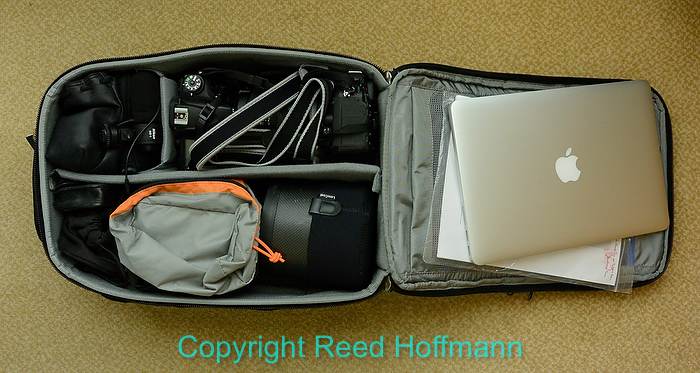
This is the Thinktank Airport Essentials bag I use, with my all the gear that I take to Africa. Photo copyright Reed Hoffmann.
I always bring two camera bodies, both for insurance (in case one fails) as well as composition. That means I bring one Nikon DX body and one FX (last year the D7200 and D750). Thanks to the crop factor of the DX body, I use it for almost all my long-lens photography. I’ll keep a tele on the DX body and a wide-angle on the FX body. Of course, I can always swap bodies and lenses to get a different angle of view, which sometimes comes in handy. It’s also nice that both of those bodies share the same battery and charger, so I’ve only had to bring one spare battery (three total) and one charger. And both use SD cards.
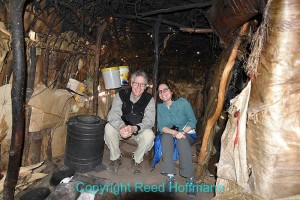
This is what the inside of one of the Maasai huts looks like, with flash. You’ll probably get to visit one during the tour of their village. Photo copyright Maasai warrior.
For lenses, on the first couple of trips I brought a wide zoom like the 17-35, plus a 70-200 and 200-400. With the introduction of the new 80-400 a few years ago, I now carry a wide zoom (either the 18-35 or 24-120 this time), the 80-400 and my 500mm, with a 1.4 converter. You’re only allowed out on game drives during daylight (no night drives because they’re so disruptive to the animals’ normal behavior), so there’s not a lot of call for high ISO or very fast lenses. The only time a fast lens might be handy is when visiting the Maasai. They’ll show you their huts, which are tiny, cramped and very dark inside. I might bring a 50mm 1.8 lens for that sort of thing, but probably won’t. Instead I’ll crank up the ISO and use my wide zoom.
And of course, double-check all your gear to make sure it’s working properly before you leave for Africa. You won’t be able to get anything fixed there, and Arusha (the only city of any size we’ll pass through) doesn’t have much in the way of camera stores. And once out on safari, there’s nothing.
You’ll want a good backpack for carrying your camera gear on the planes, and they’re nice to work out of in the trucks too. But don’t go crazy on size and get a giant one. I also pass on the ones with wheels, because that adds weight and bulk. I’m a big fan of Thinktank bags, and find the Airport Essentials to be the perfect size for me. I can fit all my above gear in it, plus the 13-inch laptop in the outer sleeve. You can read what I have to say about bags and gear here.
On Safari
Management of the Serengeti is designed around being as minimally intrusive of the wildlife as possible, to keep their lives as natural as possible. We’ll see wildlife at all kinds of distances from the trucks, but unlike some places in Africa, where they chase animals with the trucks, that’s illegal here. In other words, they can’t leave the roads. Every trip I’ve done we’ve had some amazing close encounters, with animals near the road, and other times they’re just too far away to make a good picture. That’s all part of being on safari, and it’s better to accept it as being best for the welfare of the animals instead of getting frustrated.
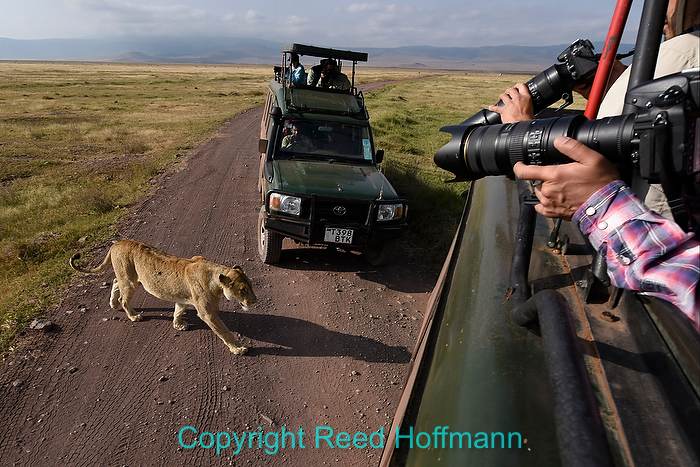
While the trucks aren’t allowed to leave the roads in the Serengeti, you’ll still have some close encounters with wildlife. Nikon D750, Aperture Priority, ISO 200, 1/250 at f/11, EV -0.7, Nikkor 18-35mm lens at 20mm. Photo copyright Reed Hoffmann.
You’ll do 98% of your shooting from inside the trucks, so there’s almost no need for a tripod or monopod (can’t use them in the trucks). However, when we visit the Hippo Pool you can use a monopod, because we’re out of the trucks, on top of a bluff overlooking the pool. There’s also a wood rail there which you can rest the lens on if the height works for you. In all the trips I’ve done, I’ve used a tripod twice (for some night photography around the lodges). So I generally don’t bring one, but if I do, it’s very light and compact.
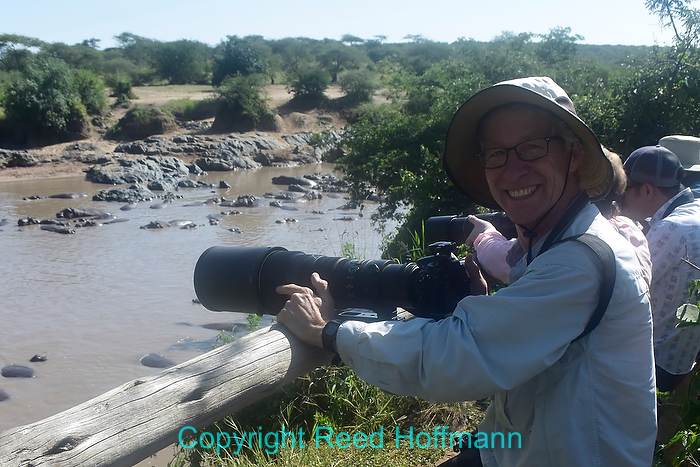
This snapshot of me shows the Hippo Pool we visit, and the railing you can use to support a big lens. Photo copyright Sharon Hoffmann.
We limit the number of photographers in each truck to four to make sure everyone has room to shoot. However, you still need to work together and be considerate of the others. If one person is trying to shoot and another starts moving around in the truck, the whole truck shakes, and can result in blur. Slow and easy is the way to move when people are shooting. The trucks can be quite bouncy while traveling, so if you’re prone to motion sickness, you’ll want one of the seats toward the front, and may want to bring medication to combat that.
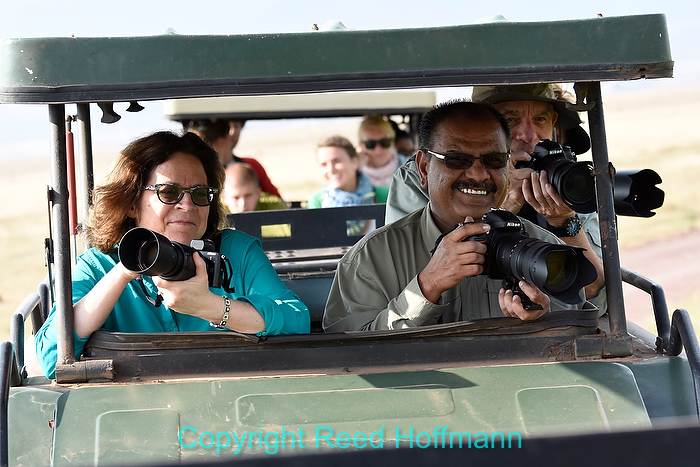
I love these trucks because you can stand up and shoot, and move around. It’s my favorite design of truck that’s used in Africa on safari. Nikon D7200, Aperture Priority, ISO 200, 1/160 at f/8, EV 0.0, Nikkor 80-400mm lens at 116mm. Photo copyright Reed Hoffmann.
The roofs of the truck pop up, so you stand up and shoot out the top. Which means you can rest your lenses on the rim of the roof. That’s easier to do if you use a bean bag. You can buy fancy expensive ones, but I always tell people to simply buy a stuff sack at a local outdoors shop. Shouldn’t cost more than about $10, and empty takes up almost no space. Then, on the way out of Arusha the first day, we can stop at a grocery store and buy a large bag of beans to put inside it. VERY IMPORTANT – do NOT open the bag of beans. Otherwise you’ll have beans all over the truck. Leave them in the heavy plastic bag they’re sealed in. When the trip’s over, it’s nice to leave the beans behind for the drivers.
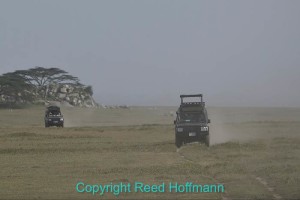
It’s mostly dry while we’re there, which means plenty of dust from the trucks. Photo copyright Reed Hoffmann.
It can get dusty in the trucks, so I rely on two things to protect my gear. First, I keep gear I’m not using zipped up inside the backpack. We usually stack the backpacks on the rear bench seat, which leaves the other four individual seats in back free for us. There’s also often an open seat up front, across from the driver, which is the most comfortable in the truck though it’s not a great spot to shoot from. But getting cameras out of the backpacks can take time and you’ll miss shots. So you want to have at least your long lens camera in your lap, and the best way to protect it is with a large pillowcase or cotton laundry bag. It’s easy to stuff the camera in there when not shooting, and easy to get out too. That way the cloth keeps dust off the camera and lens. At the end of the day, just shake it out (outside the truck, of course!) and it’s ready for the next day.
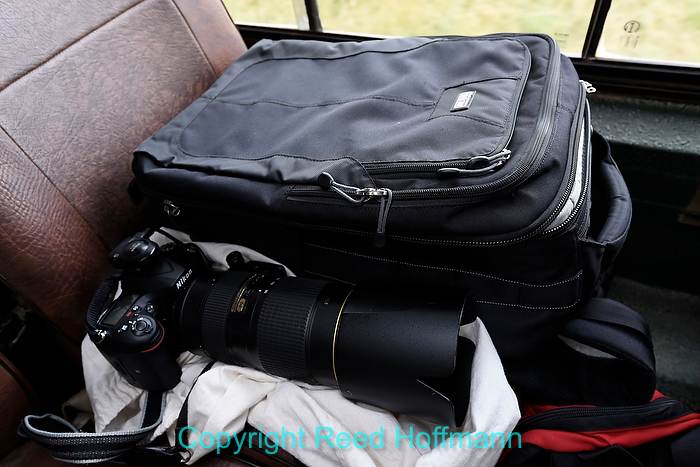
Here’s my pack on the back seat, with camera and lens outside the laundry bag I use to keep dust off them. Photo copyright Reed Hoffmann.
I tell people, “time equals opportunity” on safari, so we spend long days in the trucks. We usually leave early, as soon as we can, and don’t come back until dusk. The lodge will prepare box lunches (with more food than one person can eat!), and there are a few places in the park with restrooms (and occasionally concrete picnic tables) where we can stop. Sometimes we even eat in the trucks, if we’re at a good location waiting for animals to do something.
The temperatures usually range from 60s to 80s, so I’ve never been cold there. Bugs are rarely a problem, though occasionally we’re visited by tsetse flies, which bite like horseflies (and hurt just as much!). The only bug dope I’ve ever found to be useful against them is stuff that has citronella in it. While I’ve never had much luck with that against mosquitos, apparently tsetse flies don’t like it. I also find that long pants and shirts (thin travel ones) discourage them, and keep the sun off my tender skin. Plus a good sun hat with a string to keep it from blowing off (in the trucks) is essential.
Finally, the drivers aren’t just drivers, they’re trained and licensed guides. They have an incredible amount of knowledge, so I recommend you take advantage of that. They also work mostly for tips, so will bend over backwards to try to make sure you have a great time. Please keep that in mind when tipping them at the end.
Lodges
The lodges and camps we stay in are quite nice. While there’s always been internet, it’s been slow and spotty and sometimes only in the lobby. Last year, though, almost all the lodges had it throughout the grounds. You won’t be sending high-rez files, but you will be able to post and stay in touch.
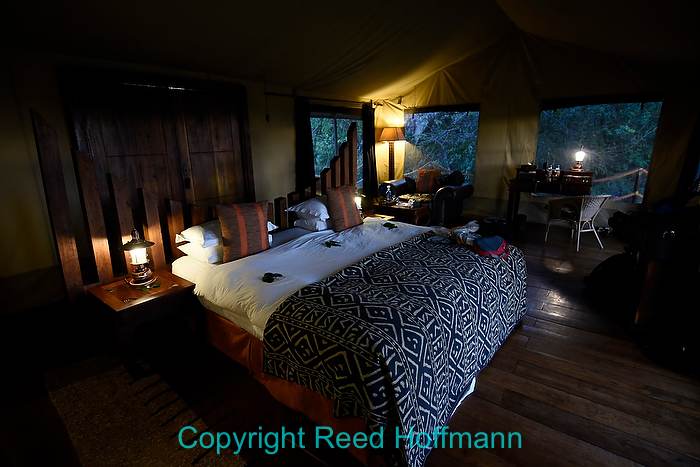
This is one of the rooms we stayed in at one of the “tented” camps. Like no camping you’ve ever done! Photo copyright Reed Hoffmann.
The food at the lodges is quite good, so I guarantee you won’t go hungry. However, like most places off the main grid, try to avoid anything that hasn’t been cooked or peeled, and drink only bottled drinks. Make sure you get a prescription for an antibiotic like Cipro from your doctor, in case you do have stomach troubles. I also use sleeping pills the first few nights to help me shift time, since we’re on the other side of the world.
Power is 220, and all of the lodges, as of last year, have it on 24-hrs a day. That, of course, means you can charge batteries overnight. Just be sure and have the right plug adapter(s).
I always travel with a small laptop, so I can download each night. I also bring enough cards that I don’t need to re-format them, so once a card is nearly full it goes back in the pouch as a backup. That way I don’t need to bring an external drive. And just like with the camera gear, check everything to make sure it’s all working properly before coming on the trip.
That’s about it. Africa is a magical place, and being on safari is the trip of a lifetime. If you want to see galleries from the past trips I’ve led there, you can find them here.
Here’s my backpack gear list for the trip in 2015:
Camera Gear – in Thinktank Airport Essentials
Nikon D750
Nikon D7200
Extra battery
One charger
Nikkor 500mm f/4
Nikkor 80-400 f/4.5-5.6
Nikkor 50mm f/1.4
Nikkor 18-35mm f/3.5-4.5
Nikkor TC 1.4 teleconverter
One grad, one polarizer
GPS for cameras
Africa paperwork
MacBook 13” Retina
1TB SSD drive
32GB USB stick
5 32GB SD cards, 2 64, 1 16, one 16GB CF card
Power adapters
Monocular
(If you decide to order anything from Thinktank, this link will get you a free gift with every order over $50)

